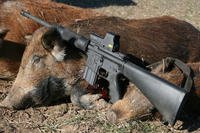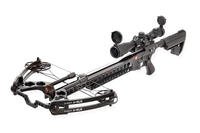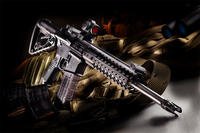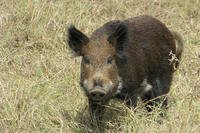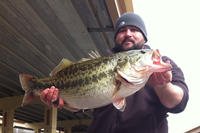Can this product of a barbeque and a cold brew become the next deep-woods superstar?
by Ralph M. Lermayer
There are several ways new cartridges come into the world. One is the military. They put out a request for a set of specs they want, and arsenals and commercial manufacturers go into high gear until the round is created. The .308, .223, 7mm Mauser, and venerable .30-06 were all created this way.
Then, there are the guys in lab jackets at the commercial plants who try to bring out new commercial cartridges with a little more oomph and, hopefully, sales appeal. The recent rush of short and super-short cases that followed the .300 RUM are a perfect example of this, as are the .444 Marlin, .338 Federal along with many others.
Then, of course, you have the "wildcatters" who take everything out there and neck it up and down just to see what happens. Occasionally they hit a home run, and the likes of the .22-250, .257 Roberts, 6.5x284, or .224 TTH are born.
This cartridge, however, the .458 SOCOM (.458 Special Operations Command) was reportedly given birth over a barbeque and some cold brew. It was at an informal gathering of special ops personnel, specifically Task Force Ranger, when the subject of stopping power came up. It seems it took multiple hits to permanently take the opposition "out of the game" in Mogadishu, Somalia. The consensus was a one-shot stop would sure be nice. Marty ter Weeme, founder of a company called Teppo Jutsu, L.L.C., went to work. In 2000 a sledgehammer cartridge that would launch 250- to 600-grain .45 caliber bullets from a standard size AR-15 with a proper barrel and chamber was born — enter the .458 SOCOM.
A Bit of AR History
Back in the late '50s, the military decided to replace the venerable Garand. Most of the companies bidding for the new gun contract assumed another .30 caliber was the way to go, and the early designs submitted were in .30-06 or .308. ArmaLite's entry, called the AR-10, was a semi-auto of simple design (with a full-auto option) chambered in .308. As is often the case with government requests, about halfway through the trials, the higher brass decided the emerging dust-up in Asia would be a close quarter affair, and it might be better to abandon the bulkier, heavier .30 caliber and move to a smaller, lighter, faster round. That sent all the competitors who were bidding for the lucrative new rifle contract back to the drawing board.
ArmaLite engineers simply took their .308 AR-10, made it smaller, chambered and timed it for a new, hot .22 based on a blown-out .222 called the .22 Special, later named the .223, and resubmitted it as the AR-15. The rest is history. The Government bought it, Colt bought the design rights from ArmaLite, and AR-15s wearing a Colt logo tromped the rice paddies of Vietnam for years, going on to become the primary military firearm to this day.
Sounds Simple, But...
What does all this have to do with the .458 SOCOM? It's a size and timing thing. Because of the small size of the AR-15 action and receiver area, and the timing of the bolt cycle rate, you can't really use cartridges much longer in overall length than the .223 (a max of 2.26 inches OL). You can make a fatter case work, but you can't be very much longer. The pressure and burn rate must also be close to that of the .223 or timing goes to pot, you tear things up, and reliability suffers.
These were the design limitations Marty ter Weeme had to work around to give the little AR-15 real muscle, but it didn't stop there. The cartridge had to be suppressor-friendly, meaning it had to be capable of muzzle velocities below 1,000 fps (subsonic) and still reliably cycle the action in semi- or full-auto. That's a tall order.
The Case
The end result is a bit of an odd-looking case, but one that accomplishes all the goals. In short, a short, fat case (1.575) with a very small rebated rim (.473), minimal taper, and a slight shoulder. The case headspaces on that minimal shoulder (see drawing). It's an odd set of dimensions, but, as we will see, an extremely clever design for its purpose.
The Why Of It
In the world of bolt actions, levers, single-shots, and even handguns, hunters have an abundance of big-bore .45 caliber options to choose from, ranging from the .458 Winchester down to the .454 Casull. Big, heavy bullets moving at moderate velocities are proven game-stoppers when a fast stop is the vital objective.
The rising popularity of the AR-15 and its rapid move to the dark timber has generated a need for that kind of muscle in the AR. Other cartridges like the .450 Bushmaster or .50 Beowulf were created to fill this void. They are fine cartridges that get the job done, but they both require that the rifle be modified. Parts need to be changed to make them function. Buffer springs, unique magazines, different bolt, etc., are required.
The real cleverness in the design of the .458 SOCOM is that nothing but the upper need be changed — same magazine as the .223, same buffer spring in the buttstock, same everything. Just get a .458 upper available from Rock River Arms, Teppo Jutsu, or other custom builders, get loaded ammo from SBR Ammunition, Corbon, or Reeds and go. Now, your .223 AR has morphed from a varmint getter to a full-fledged deer-, bear- and elk-stopper by simply changing the upper — no new FFL transfer required.
In The Field
Much of the research on the capabilities of big-bore AR-15 rounds like the .458 SOCOM concentrate in the area of subsonic (1,050 fps and lower velocities) and suppressed loads. That's the where and why of the super-heavy 450-, 500- and 600-grain bullets. I would imagine folks hiking, fishing or living in big bear country might also opt for the heavy weights. The Coast Guard uses them to put big holes in bad boats, but for hunters, bullets in the 250 to 350-grain range will be the most useful.
A 300-grain, well-constructed bullet moving at about 2,000 fps is 150- to 200-yard bad medicine for just about anything, including bear and moose. It's certainly big enough for elk, and there's not a deer alive that will walk away from a solid hit. The energy of such a combination is 2,400 foot-pounds at the muzzle and, within 100 yards, it doesn't weaken much. That puts it squarely in the territory of the modern .45-70 or .450 Marlin, and it will do anything those rounds will do. The mighty .458 Winchester Magnum only bumps 2,100 fps with the 300-grainers.
Of course, all of these other cases soon outperform the .458 SOCOM as bullet weights get heavier since they have the case capacity to push the 400-, 500- and even 600-grain heavy weights much faster. With those weights, you don't have enough powder capacity in the .458. Velocity drops fast, and they slow way down and go subsonic, precisely as the design required.
Reloading
Dies are available from Hornady, Lee, CH, and soon will be available from Redding. Bullet choices are vast with Nosler, Hornady, Barnes, Speer, Woodleigh, Swift, A-Frame, Sierra, and Lost River all offering great bullets in .458 from 250 to 600 grains. Both Remington and Winchester produce bulk bullets in .458. Whatever your preference, bullets won't be a problem, nor will the large pistol primers this case uses. A wide diversity of powders have also proven accurate in the SOCOM from Hodgdon's Lil Gun to 4198. It's a very easy case to load for, as long as your dies don't push the minimal shoulder back.
The one component that is currently in short supply is cases. They are made by Starline and available from them, Midway or Graf & Sons, but due to a fast-rising demand and the general shortages we've experienced since the last election, there are currently brass shortages, and orders are going on backorder. Both Starline and CorBon assure me that supplies should increase by the time this goes to press.
At The Bench
My test rifle is a Rock River A4 upper and lower, flat top receiver with a 3-9 scope mounted on medium rings. In my opinion, 200 yards is this rifle's practical hunting range. Good shooters will no doubt stretch that a lot, with high BC bullets, but big game is way different than steel gongs. After the accuracy testing, the more precise, higher-magnification scope will be replaced with either a 3X or 4X ACOG or a red dot for faster target acquisition. The rifle is fitted with the Rock River match trigger, but no other modifications are made — pretty much stock as delivered by Rock River Arms.
Rock River offers either complete rifles or just uppers in .458. As of now, they only offer a 16-inch chrome barrel with a flash hider (good to protect the crown, even if you're not concerned about flash), and no front sight. I wish an 18- or 20-inch barrel were available. It would quiet things down quite a bit and probably add a bit more velocity.
The Rock River line is known for quality, and this rifle is no exception. But were I to have their ear as to the design, it would have an elevated optical platform (EOP) to get the scope up a bit higher, and a real recoil pad!
For all the myriad of aftermarket parts available for ARs, volumes of catalogues or aftermarket goodies, no one offers an A2-style buttstock with a real recoil pad. The standard hard plate, more than adequate for the .223, is a real meat grinder with the .458. There is an ACE skeletonized buttstock that comes with a ½- or 1-inch rubber pad, and my order went in to Brownells immediately after doing the testing. I have it on good authority that DPMS will be offering an A2 buttstock with a real recoil pad in the near future. Stay tuned.
Corbon factory loads with what appears to be a 300-grain Sierra FBHP were the only loads I had available. Dies ordered from Hornady have not yet arrived. Pulling the bullet showed a powder charge of 29.2 grains of a flake powder that filled the case to about 2⁄3 capacity. A lot of powder room was left in that case. I'm anxious to work up reloads, but you can't hotrod AR loads. They must be loaded to a narrow pressure. Velocity range or timing goes to pot and reliability suffers. Hot loads are more trouble than they're worth. Over the chronograph, velocity 15 feet from the muzzle measured 1,927 fps with a deviation of 18 fps — very consistent performance — and it showed on the target.
A bit on the results before I go on. If you're like me you soon get pretty suspicious of gun writers who seem to get sub 1-inch, 100-yard groups from everything they shoot. Maybe they have a magic trigger finger. That's not the way things are in the real world.
This factory load from this unmodified rifle never exceeded 2 inches at 100 yards, with most groups holding at 11⁄2 inches and several sub 1-inch clusters in the mix. That is extraordinary accuracy from an unmodified semi-auto rifle. I am not surprised. Short cases moving heavy projectiles at moderate velocities are usually capable of excellent accuracy, but this is exceptional.
I fired about 50 rounds downrange, all fed from standard 10-round .223 magazines. The .223 magazine only hold three rounds of .458, making it legal for hunting where magazines are limited to five rounds or less. There was never a failure to feed, it never jammed, or gave me a problem of any sort. This AR design likes this load. Other loads for reloaders are available from the Teppo Jutsu Web site, and a lively reloading discussion is always underway at the .458 SOCOM Forum.
Bottom Line
Thoughts of AR-15s automatically lean towards their most familiar load, the versatile.223, and the expansion to .204, 6.8, .30 Remington AR, and the like have given it solid deer and antelope hunting credentials.
No one will argue the effectiveness of those cartridges on deer, but for bear, elk, and moose, the job had to be left to its bigger, heavier brother, the AR10 — where the mega rounds are found. No more. With the introduction of the .458 SOCOM, the trim AR-15 is more than tough enough for the big guys.

